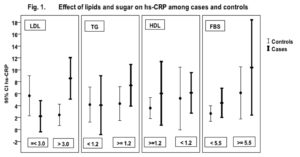Introduction
POLYCYSTIC OVARY SYNDROME (PCOS) is the most common endocrinopathy of women in the reproductive age group (Carmina 1999). Hyperinsulinemia independent of obesity and impaired glucose tolerance in obese PCO women were reported by Duniaf et al., (Dunaif 1987). Many women with PCOS have additional features of the metabolic syndrome like diabetes and obesity… Lean women with PCOS were found to have a higher prevalence of hyperinsulinemia and ovarian stimulation by insulin appeared to be independent of luteinizing hormone in these women.(, Conway 1990) PCO women were found to have significant insulin resistance than weight-matched control subjects (Dunaif 1989, Rajkhowa 1994, Morales 1996). Legro wt al., reported in women who have PCOS, as many as 30% have impaired glucose tolerance (IGT) and an additional 7.5% have diabetes and even among non obese women with PCOS, 10.3% have IGT, and 1.5% have diabetes and that PCOs is a more important risk factor in young women to develop glucose intolerance (Legro 1999). Low-grade systemic inflammation, as indicated by elevated hsCRP levels, with Type 2 diabetes mellitus (T2D) was demonstrated in the North Indian population by Mahajan et al., (Anubha 2009). This association was independent of obesity.
Elevated high sensitivity C- reactive protein (hs-CRP) was found to be associated with cardiovascular risk factors in normoinsulinemic PCOS women (Verit 2010). We intended to study the relationship of elevated hs CRP and other biochemical parameters of metabolic syndrome like lipids and fasting blood sugar in PCOS women and age and BMI matched controls.
Methods
Sixty women with Polycystic Ovary syndrome (menstrual irregularity due to oligomenorrhea or anovulation, clinical or biochemical evidence of hyperandrogenism and or polycystic ovaries on ultrasound examination — two of the three criteria to be met as per Rotterdam criteria) were recruited from the infertility clinic. Sixty healthy controls with regular menstruation, matched for age (±1 year margin) and body mass index (BMI ± 1 margin) were recruited. hs-CRP was measured in all women (cases and controls) and the blood venous sample was drawn in the morning. Women with Cushing’s syndrome, late onset 21-hydroxylase deficiency, thyroid dysfunction and androgen secreting tumours were excluded. Patients and controls on hormonal contraceptives, statins, and aspirin were excluded and so were women with any acute infection.
High sensitive C – reactive protein (hs -CRP) was estimated in 60 women with polycystic ovarian syndrome (PCOS) and 60 women matched for age and weight with regular menstruation. In a subset of 18 women other parameters like fasting blood sugar (FBS), low density lipoproteins (LDL), triglycerides and high density lipoprotein were estimated.
Statistical Analysis
Kolmogorov-Smirnow test was used to test the normality of the variables under study and it showed that all the parameters were obeying the normal distribution pattern among cases and controls. Pearson coefficient of correlation was used to obtain the degree of relationship between hs-CRP and other parameters and independent sample t —test was applied to test the significance of difference of hs-CRP means between normal and abnormal parameters among cases and controls. A p value of 0.05 has been taken as significant.
Assays
High sensitive C reactive protein was assayed using Cobas Integra systems. (Cobas Integra C-Reactive Protein Latex; Roche Diagnostics). The test principle was based on particle enhanced turbimetric assay. Human CRP agglutinates with latex particles coated with monoclonal anti CRP antibodies. The precipitate is determined turbimterically at 552nm. All samples were analyzed in one assay. The samples were stored — 80 degree Celsius. The intra-assay coefficient of variation was 1.8% and the interassay coefficient of variation was 2.9% at a mean level of 0.62 mg/dl CRP (similar to the manufacturers). HDL cholesterol (HDL), Low density Lipoprotein (LDL) and triglycerides were measured using Cobas Integra 800 (Roche diagnostics) by homogenous enzymatic colorimetric method.
Fasting blood glucose also was estimated with Cobas Integra 800 (sensitivity 0-40mmol/L, co efficient of variation 0.72% to 1.5%).
Results
The mean age of (PCOS) patients was calculated as 27.00 ± 5.21 and for controls it was 27.35 ± 4.87. The mean BMI of the PCOS women and controls were found as 28.65 ± 5.63 and 28.75 ± 5.22 respectively. A significant positive relationship was observed between BMI & level of hS-CRP in the whole sample, 114 (r = .520, P < .0001). This relationship was found stronger among (PCOS) patients (r = .625, P < .00001) than controls (r = 393, P = .003). These findings have already been published (Gowri 2010).
In a subgroup of 18 cases and 18 controls fasting blood glucose (FBS), Low density cholesterol (LDL), high density cholesterol (HDL) and triglycerides (TG). The mean age of the controls and cases subgroups was 28.3±6.2 years and cases are 28.8± 5.4 years respectively. The mean BMI in controls was 30.1± 4.2 and in cases was 31.0 ± 5.2. The mean hs CRP in controls was 4.2 ± 4.0 iu and cases was 6.1 ± 5.4 iu.
The relationship of hs CRP with FBS, LDL, HDL and TG among cases and controls is presented graphically in table 1. Fig. 1 and table 2 display the impact of lipids and glucose on hs-CRP among cases and controls. The hs CRP was significantly more in PCOS women when the LDL was more than 3 mmol/l and the FBs was equal to more than 5.5 mmol. This effect was not seen in controls.
Discussion
The metabolic syndrome is composed of abnormalities like elevated fasting glucose, hyperlipidemia, obesity and hypertension. There were various definitions for the metabolic syndrome and the National Cholesterol Education Program (NCEP) definition includes fasting glucose, waist circumference, blood pressure, and lipid criteria pertaining to triglycerides and HDL cholesterol (NCEP 2001). Metabolic syndrome is a significant predictor of cardiovascular disease but a stronger predictor of type 2 diabetes.
Many patients with polycystic ovary syndrome (PCOS) also have features of the metabolic syndrome, including insulin resistance, obesity, and dyslipidemia compared to weight matched controls and this contributes to an increased risk for cardiovascular disease (Sharpless 2003).Obese women with PCOS also have a dyslipidemia. Elevations of low density lipoprotein cholesterol were the main abnormality in women with PCOS. (Legro 2001). However Holte et al., reported plasma free fatty acid correlations were markedly increased in obese women with PCOS closely associated with lower insulin sensitivity and lower glucose tolerance. They did not find the lipoprotein lipid profile significantly abnormal in obese PCOS women compared to weight matched controls. (Holte 1994).
Metabolic complications associated with insulin resistance are increased in PCOS independent of obesity including an adverse cardiovascular risk profile (Lakhani 2004). High sensitivity C-reactive protein (hs- CRP) is an acute phase reactant hepatically synthesized in response to IL6 and TNF-a(Clearfield 2005). Elevated levels of hS CRP are linked to visceral fat accumulation, Insulin resistance, the metabolic syndrome and type 2 diabetes mellitus (Lemieux 2001). It is still not clear whether elevated hs-CRP in women with PCOS is due to obesity or the disease itself. (Meyer C, 2005). Since the hs- CRP was significantly high in women with obesity, the authors in the present study compared the other parameters contributing to metabolic syndrome in women with PCOS and the controls. We found that hs -CRP significantly more in PCOS women when the LDL was more than 3 mmol/l and the FBS was equal to more than 5.5 mmol, though the effect of obesity was not tested. It is likely that women with PCOS are at increased risk of cardiovascular risk due to elevated LDL and FBS in addition to obesity, but this needs a larger sample size.
The main limitation of the study is sample size. There is an international concern on emerging epidemic of type 2 diabetes and obesity. . Even some others have queried if PCOS is an early manifestation of metabolic syndrome. A larger study is needed to clarify if metabolic syndrome parameters are related only to obesity or PCOS itself.
References
1. Anubha M, Rubina T, Sreenivas C, Om Prakash D, Mausumi B, Nikhil T and Dwaipayan B (2009) High-Sensitivity C-Reactive Protein Levels and Type 2 Diabetes in Urban North Indians The Journal of Clinical Endocrinology & Metabolism, 94(6); 2123-2127
2. Carmina E, Lobo R Polycystic ovary syndrome (1999) “Arguably the most common endocrinopathy is associated with morbidity in women”. J Clin Endocrinol Metab, 84 (6) 1897—1893.
Publisher – Google Scholar
3. Clearfield MB (2005) C-Reactive protein : a new risk assessment tool for cardiovascular disease J Am Osteopath assoc, 105 (9)409-416.
4. Conway GS, Jacobs HS, Holly JM, Wass JA (1990) “ Effects of luteinizing hormone, insulin, insulin-like growth factor-I and insulin-like growth factor small binding protein 1 in the polycystic ovary syndrome” Clin Endocrinol (Oxf), 33 (5) 593—603.
Publisher
5. Dunaif A, Segal KR, Futterweit W, Dobrjansky A (1989) Profound peripheral insulin resistance, independent of obesity, in polycystic ovary syndrome. Diabetes, 38 (9)1165—1174.
Publisher – Google Scholar
6. Executive Summary of the Third Report of The National Cholesterol Education Program (NCEP) Expert Panel on Detection (2001), Evaluation, And Treatment of High Blood Cholesterol In Adults (Adult Treatment Panel III). JAMA, 285 (19) 2486—2497.
Publisher
7. Gowri V, Rizvi S, Shabnam S , Al Futaisi A (2010) High-sensitivity C-reactive protein is a marker of obesity and not of polycystic ovary syndrome per se. Fertility Sterility, 94 (7) 2832-2834
Publisher
8. Holte J, Bergh T, Berne C, Lithell H (1994) Serum lipoprotein lipid profile in women with the polycystic ovary syndrome: relation to anthropometric, endocrine and metabolic variables. Clin Endocrinol (Oxf), 41 (4) 463—471.
Publisher – Google Scholar
9. Lakhani K, Prelevic GM, seifalian AM, Atiomo WU, Hardiman P (2004) Polycystic Ovary syndrome, diabetes and cardiovascular disease: risks and risk factors. J Obstet Gynaecol, 24 (6) 613-621
Publisher
10. Lemieux I, Pascot A, Prud’homme D, Almeras N, Bogaty P, Nadeau A, Bergeron J, Depres JP (2001) Elevated C —Reactive protein. Another component of the atherothrombotic profile of abdominal obesity. Arterioscler Thromb vasc Biol , 21 (6) 961-967.
Publisher – Google Scholar
11. Legro RS, Kunselman AR, Dunaif A (2001) Prevalence and predictors of dyslipidemia in women with polycystic ovary syndrome. Am J Med , 111 (8)607—613.
Publisher – Google Scholar
12. Meyer C, Mc Grath B P and Teede H J (2005)Overweight women with Polycystic Ovary Syndrone have an Evidence of Subclinical Cardiovascular Disease J Clin Endocri Metab, 90 (10) 5711-5716
13. Morales AJ, Laughlin GA, Butzow T, Maheshwari H, Baumann G, Yen SS (1996) Insulin, somatotropic, and luteinizing hormone axes in lean and obese women with polycystic ovary syndrome: common and distinct features. J Clin Endocrinol Metab 81 (8)2854—2864.
Publisher – Google Scholar
14. Legro RS, Kunselman AR, Dodson WC, Dunaif A (1999) Prevalence and predictors of risk for type 2 diabetes mellitus and impaired glucose tolerance in polycystic ovary syndrome: a prospective, controlled study in 254 affected women. J Clin Endocrinol Metab, 84 (1) 165—169.
Publisher – Google Scholar
15. Morales AJ, Laughlin GA, Butzow T, Maheshwari H, Baumann G, Yen SS (1996) Insulin, somatotropic, and luteinizing hormone axes in lean and obese women with polycystic ovary syndrome: common and distinct features. J Clin Endocrinol Metab 81 (8)2854—2864.
Publisher – Google Scholar
16. Rajkhowa M, Bicknell J, Jones M, Clayton RN (1994) Insulin sensitivity in women with polycystic ovary syndrome: relationship to hyperandrogenemia. Fertil Steril, 61 (4) 605—612.
17. Sharpless JL (2003) Polycystic Ovary Syndrome and the Metabolic Syndrome. Clinical Diabetes, 21(4) : 154-161
Publisher
18. Verit FF (2010) High sensitive serum C-reactive protein and its relationship with other cardiovascular risk factors in normoinsulinemic polycystic ovary patients without metabolic syndrome. Arch Gynecol Obstet, 281 (6)1009-1014.
Publisher – Google Scholar





